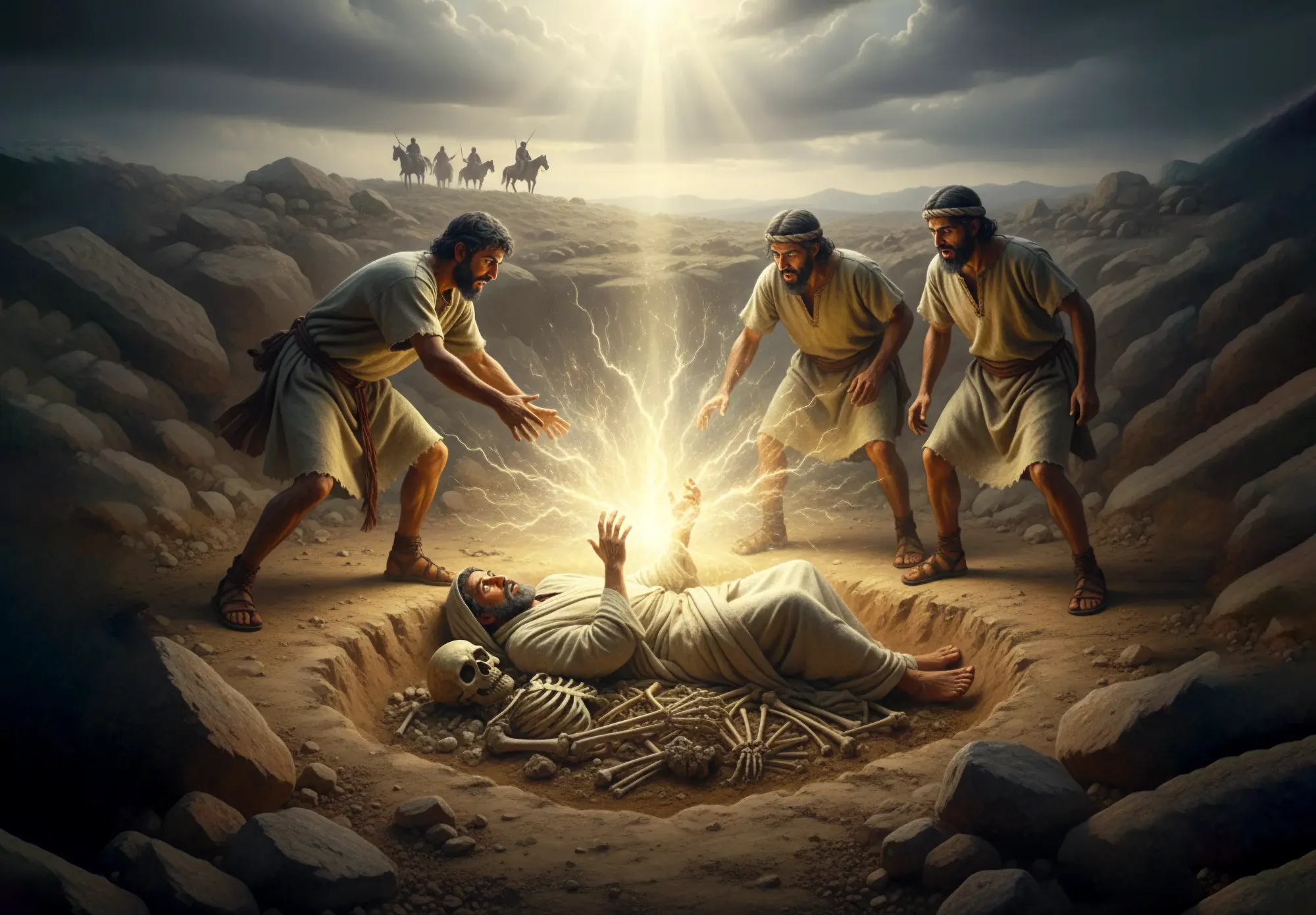Miracles Reconsidered: Two Case Studies from the Lives of Elijah and Elisha

As a professional magician and author, I have spent years investigating claims—supernatural, paranormal, or otherwise—to see how well they hold up under scrutiny. Here, I will examine two biblical accounts involving the prophets Elijah and Elisha, stories often described as miracles, but which may not necessarily require that interpretation. The analysis draws on my broader research into dozens of miracle accounts, biblical and otherwise, focusing on careful reading of the text in context. We’ll work through the process together: considering their original context, the perspective of the initial audience, and relevant linguistic, cultural, and scientific factors.
Not every event described as extraordinary in the Bible is necessarily intended as a miracle.
Prophets like Elijah and Elisha, active in Israel’s northern kingdom during the 9th century BCE, are featured in biblical narratives describing remarkable events. Elijah’s accounts often highlight dramatic confrontations and symbolic acts, while Elisha’s stories emphasize healing, provision, and restoration. Both demonstrate the authority and influence attributed to prophets, but the narratives differ in tone, focus, and style. Examining these differences highlights the textual choices and emphases that shape how the events are described, providing a foundation for careful, context-aware interpretation.
Not every event described as extraordinary in the Bible is necessarily intended as a miracle. Some accounts highlight surprising outcomes without requiring a suspension of natural law. This article examines two such examples—one featuring Elijah and one featuring Elisha—to illustrate how historical context, language, and cultural practices provide alternative ways to interpret these stories.
Case Study 1: Elijah Outruns a Chariot
Following a devastating three-year drought and the execution of 450 prophets of Baal by King Ahab, 1 Kings 18:46 records: “Then the hand of the Lord was on Elijah, and he belted his cloak around his waist and outran Ahab to Jezreel.” Many readers interpret this passage as describing Elijah being supernaturally empowered to outrun a horse-drawn chariot—a feat that would seemingly qualify as miraculous, but does the text actually support that interpretation?
Examining these differences highlights the textual choices and emphases that shape how the events are described, providing a foundation for careful, context-aware interpretation.
Some have pointed to Jeremiah 12:5 as implying that outrunning a horse might be possible. In this verse, God challenges the prophet: “If you have run with infantrymen and they have tired you out, How can you compete with horses?” Rather than suggesting the feat is physically possible, the passage uses hyperbole to make a rhetorical point: those struggling with smaller challenges shouldn’t expect to succeed at greater ones.
The phrase “the hand of the Lord was on [name]” appears frequently in the Hebrew Bible and is generally understood as a figure of speech. Depending on context, it can indicate that a prophet felt compelled to act (as in the Elijah account), experienced inspiration (Jeremiah 15:17), or received authority for a particular role (Ezekiel 1:3). It does not necessarily imply supernatural strength or speed.
In Elijah’s case, if the phrase is read as indicating he felt compelled to act, practical considerations of travel become central. Horse-drawn chariots in antiquity were powerful but not built for sustained high-speed travel over long or difficult terrain. Uneven ground, muddy roads after rain, and the limited endurance of horses would reduce overall speed. Conversely, a person accustomed to walking or running long distances could cover ground more efficiently, particularly along a direct path.
Not every event described as extraordinary in the Bible is necessarily intended as a miracle.
It is important to note that the text does not specify Elijah and Ahab began from the same location. Elijah had already sent his servant to instruct Ahab to “go up” and eat and drink; “go up” may indicate a different spot on Mount Carmel or follow the biblical idiom for traveling to Jerusalem. By the time the message reached him, Elijah may already have begun his journey—likely before the first rains arrived. This renders a competitive race improbable; instead, Elijah’s advance reflects a purposeful journey, possibly along a more direct route, explaining his arrival before Ahab without invoking supernatural speed.
In 1 Kings 18:46, the Hebrew uses the verb וַיָּרָץ (“ran”) paired with לִפְנֵי (“before”), literally “he ran before Ahab.” The same construction appears in Genesis 32:3, where Jacob sends messengers לְפָנָיו (“before him”)—to indicate moving ahead to announce, prepare, or lead the way. In biblical usage, this phrasing highlights precedence or heralding rather than speed, reinforcing that Elijah’s movement reflects purposeful, goal-directed action. Elijah’s advance may symbolize heralding—announcing the king’s return to Jezreel and signaling a tentative return to the God of his ancestors. This interpretation is especially plausible in light of the execution of the 450 prophets of Baal, which marked a decisive turning point in Israel’s widespread worship of Baal.
While Elijah’s story illustrates how language, context, and cultural practices can explain an event traditionally viewed as miraculous, the next account offers a briefer, more enigmatic episode: the revival of a man who touched Elisha’s bones.

Case Study 2: The Man Who Touched Elisha’s Bones
Some biblical accounts of extraordinary events are described in vivid detail, while others are mentioned only briefly. The passage in 2 Kings 13:21 is an example of the latter: “And as [some Israelites] were burying a man, behold, they saw a marauding band; and they threw the man into the grave of Elisha. And when the man touched the bones of Elisha he revived and stood up on his feet.”
Traditionally, theologians have interpreted the story as evidence of lingering prophetic power or a symbolic affirmation of Elisha’s status.
Unlike more developed miracle stories, this passage offers minimal context. The resurrected man is never mentioned again, and the text does not provide details about his identity, condition, or whether anyone witnessed the event. Traditionally, theologians have interpreted the story as evidence of lingering prophetic power or a symbolic affirmation of Elisha’s status. However, read in context, the passage functions more as a brief note on Elisha’s enduring influence than as a detailed eyewitness account. Some scholars classify it as etiological—a story meant to explain or reinforce the prophet’s reputation.
The northern kingdom of Israel in the 9th century BCE was politically unstable, with frequent conflict against neighboring peoples such as the Moabites east of the Dead Sea. Moabite raids created urgent, chaotic circumstances that help explain the burial scenario described in 2 Kings 13:21. The sudden appearance of raiders meant that the burial party likely had little time for careful preparation and placed the body in the first tomb available—Elisha’s.
Concerns about premature burial were widespread in antiquity, since rapid interment carried a real risk of burying someone still alive.
Burial customs reflected both religious obligations and practical concerns. Jewish law required burial on the day of death, often within hours, because the hot climate accelerated decomposition. Bodies were typically placed in rock-cut tombs or caves, where flesh decomposed over several months, leaving bones after roughly a year. Coupled with the urgency of a raid, these practices could allow someone mistakenly presumed dead to be buried without detection.
Within this context, the phrase “revived”—or “came to life” in some translations—can be understood in multiple ways. While it may indicate literal resurrection, it could also describe recovery from a state that only appeared to be death—such as unconsciousness or coma. Concerns about premature burial were widespread in antiquity, since rapid interment carried a real risk of burying someone still alive.
The biblical texts themselves provide limited detail, leaving room for interpretation. Attention to context, language, and cultural practices allows alternative readings.
Historical and modern cases illustrate this phenomenon. Essie Dunbar, an early 20th-century South Carolina woman, suffered an epileptic seizure and was declared dead; when exhumed at her sister’s insistence she was found to be alive. In 2015, Neysi Pérez, a pregnant teenager in Honduras, was pronounced dead and buried, only to be heard screaming from inside her tomb the next day. Even George Washington requested a delay in burial to avoid the risk of premature interment. (Caskets in these times were sold with an external bell that could be rung from inside.) In this context, it is plausible that the man in 2 Kings 13:21 was mistakenly presumed dead, and that being moved into Elisha’s tomb—combined with shock, cool air, or physical impact—could have revived him.
The story’s inclusion likely owes more to the fact that the tomb belonged to Elisha than to any detailed description of miraculous power. Elisha’s reputation as a prophet would have made any unusual event linked to his remains noteworthy to later storytellers and editors of the biblical text.
Reframing the Miraculous
Both stories—Elijah outrunning a chariot and the man who touched Elisha’s bones—are often cited in tradition as examples of divine intervention. However, the biblical texts themselves provide limited detail, leaving room for interpretation. Attention to context, language, and cultural practices allows alternative readings: Elijah’s running can be understood in terms of terrain, travel practices, and idiomatic expression, while the revival of the man in Elisha’s tomb may reflect mistaken presumptions of death rather than literal resurrection.
For readers examining extraordinary claims, these stories illustrate how attention to historical context, language, and cultural practices can clarify what the texts describe and why they mattered to their original audience.
Note: Biblical citations are taken from the New American Standard Bible (NASB), 2020 edition, unless otherwise indicated.